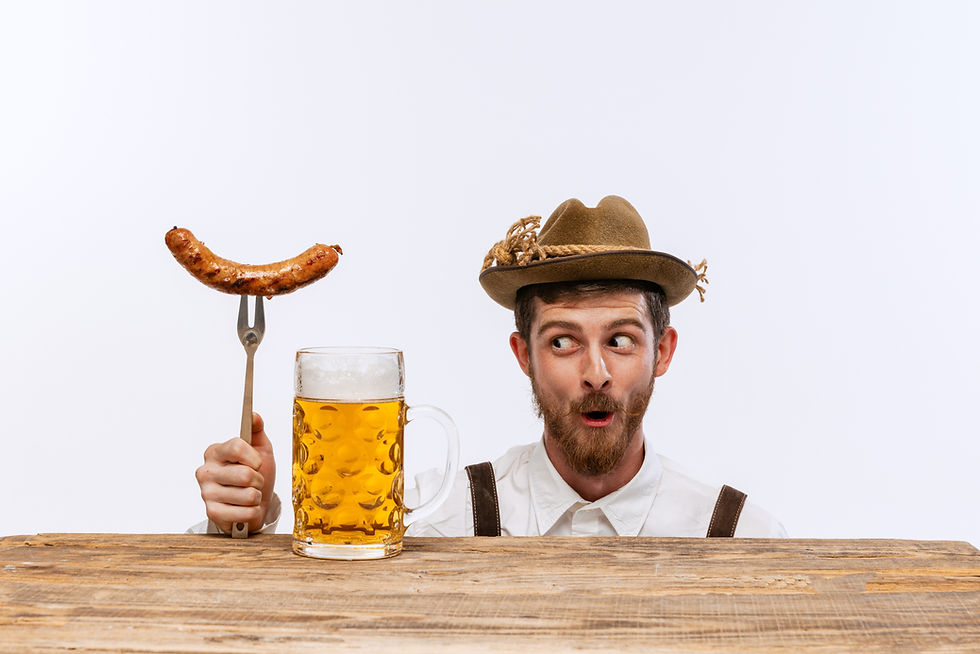A Brief History of the German Language: Evolution, Influence, and Historical Milestones
- Jens Olesen

- 3 hours ago
- 7 min read
The German language has evolved over centuries, shaped by historical events, cultural influences, and social changes. Understanding the development of German helps not only to appreciate the language as it is today but also to grasp the broader forces that have influenced the German-speaking world. This post takes you on a journey through the evolution of the German language, highlighting key historical events, periods, and linguistic shifts that have shaped its current form.
A brief history of the German language
1. Early Origins: Proto-Indo-European and the Germanic Languages
The story of the German language began long before written records were made. The earliest stages of the language's development are rooted in the Proto-Indo-European language, the hypothesised common ancestor of many European and South Asian languages. Around 2000 BCE, the speakers of Proto-Indo-European began to migrate across Europe and parts of Asia, breaking off into distinct language groups, including the Indo-Iranian, Italic, Celtic, and Germanic families.
The Germanic branch, which would eventually give rise to the German language, split from other Indo-European languages around 500 BCE. The Proto-Germanic language, spoken by early Germanic tribes in what is now Scandinavia, Denmark, and northern Germany, is considered the immediate precursor to all Germanic languages. This language was not yet recognisable as “German,” but it laid the foundation for the Germanic languages, which later evolved into distinct languages, including German, English, Dutch, and the Scandinavian languages.
2. Old High German (OHG) – The First Steps Toward Modern German
The first distinct stage of the German language, Old High German (OHG), emerged around 500 CE and continued until about 1050 CE. This period marks the beginning of the development of a language that would become more recognisable as the ancestor of modern German.
During the early Middle Ages, the German-speaking people were fragmented into various tribes and regions, each with its own dialect. These dialects were influenced by Latin, due to the spread of Christianity in the region. Latin became the language of the Church and education, and many religious texts were written in Latin, leading to an influx of Latin words into the German lexicon. For instance, words like „Kirche” (church) and „Tisch” (table) have Latin origins.
A key feature of OHG was the High German consonant shift, which profoundly changed the phonetics of the language. For example, the sound of the Proto-Germanic k (as in the English "king") became a ch sound in German, as seen in „könig” (king). Similarly, the Proto-Germanic p changed to ff, and t became z in some instances. This phonetic shift helped distinguish the High German dialects from other Germanic languages, such as Old English.
The most important texts from the OHG period are religious manuscripts and epic poems, including the "Nibelungenlied", which remains one of the most important works in the early German literary canon.
3. Middle High German (MHG) – The Influence of the Holy Roman Empire
The Middle High German (MHG) period, which lasted from roughly 1050 to 1350, was a time of significant linguistic, political, and social change. One of the most important events during this period was the formation of the Holy Roman Empire. The empire, which was established in 800 by Charlemagne, brought together a wide variety of Germanic tribes, whose dialects began to influence one another. As these regions interacted, a more standardised form of German began to emerge, influenced by the languages of the ruling elite.
One major development during the MHG period was the expansion of literature and the use of the written word. Whereas Old High German literature had been mainly religious, MHG texts became more secular, with works such as „Parzival” by Wolfram von Eschenbach and the „Nibelungenlied” focusing on chivalric themes and knightly quests.
In terms of linguistic features, MHG was characterised by the continued development of vowel shifts and the expansion of vocabulary, especially as the influence of Latin and French grew. For example, French vocabulary started to enter the language, particularly in the fields of culture, art, and diplomacy, reflecting the growing influence of French culture at the time. Words like „Burg” (castle) and „König” (king) were influenced by French and Latin.
However, MHG was still highly regional, with different dialects spoken in various parts of the Holy Roman Empire. This regional variation created a complex linguistic landscape, where a person from the Rhineland might have difficulty understanding someone from Bavaria or Saxony. Despite this, a form of written language began to be standardised, especially in the context of legal documents and royal decrees.
4. Early New High German (ENHG) – The Birth of Modern German
The period of Early New High German (ENHG), from 1350 to 1650, is often considered the transition period between medieval German and modern German. This era saw the rise of the printing press and the spread of literacy, both of which had profound effects on the German language.
The invention of the printing press by Johannes Gutenberg in the mid-15th century revolutionised the spread of written material. The first major book printed with movable type was the Gutenberg Bible (1455), which made books more widely available and helped to standardise language. As books began to be printed in German, they provided a more consistent model for spelling and grammar, though many regional variations still persisted.
A major event in the history of the German language during this time was Martin Luther’s translation of the Bible into German in 1522. Luther’s Bible had a huge influence on the development of modern German. Luther was intent on making the Bible accessible to common people, and his translation used a form of German that was based on the dialect spoken in the region of Saxony, which was more intelligible to a broad range of speakers. His Bible helped standardise German and brought written German into homes across the German-speaking world. The influence of Luther’s Bible can still be seen today in many idiomatic expressions in modern German.
This period also saw the rise of a more unified vocabulary, although regional dialects remained strong. ENHG marked the first steps toward what we now think of as Standard German. The grammar of the language was still highly inflected, with case endings and verb conjugations similar to those in Latin, but many of the irregularities began to be simplified during this time.
5. Modern High German (MHG) – Standardisation and Influence of the 19th and 20th Centuries
The final shift toward Modern High German (MHG) began in the 17th century, but it wasn’t until the 19th century that German truly began to take a more standardised form, particularly with the influence of the Grimm Brothers and the German Nationalist Movements of the 19th century.
The Grimm Brothers, particularly Jacob and Wilhelm Grimm, were linguists who collected and recorded German folklore, but they also studied the language itself. In their famous work, „Deutsche Grammatik” (German Grammar), they analysed the historical development of the German language and traced its roots back to its Proto-Germanic ancestors. Their work helped to establish the foundations of modern German grammar and linguistics.
The 19th century also saw the rise of nationalism, and the German language played a significant role in the unification of Germany. As German-speaking territories began to coalesce into a unified state (officially established in 1871), there was a push to standardise the language, both in writing and speech. The Reichsdeutsch standard emerged, influenced by the language used in Prussia, and began to be taught in schools across the country.
The 20th century brought both the rise of the Weimar Republic and the Nazi regime, both of which had their own impacts on the German language. During the Weimar Republic (1919–1933), German intellectuals and writers, including figures like Thomas Mann and Franz Kafka, continued to develop and refine the language. The Nazi regime, however, sought to impose a strict, ideologically-driven language policy, which led to the introduction of new terms and the eradication of certain foreign influences in the German language.
After World War II, the division of Germany into East and West had a lasting impact on the German language. In East Germany (GDR), the state pushed for the use of “Neusprech” (new speech), which included the standardisation of certain phrases and the promotion of a vocabulary tied to socialist ideals. Meanwhile, West Germany experienced the influence of American English, which led to a growing use of loanwords, especially in popular culture and technology.
6. Conclusion – The German Language Today
Today, German is one of the most widely spoken languages in the world, with more than 100 million speakers across Germany, Austria, Switzerland, and parts of Belgium and Luxembourg. The language continues to evolve, with modern influences from English, especially in areas such as technology, business, and popular culture.
The influence of historical events, such as the spread of Christianity, the rise of nationalism, and the impact of both world wars, has shaped the language into what we know today. From its humble beginnings as a branch of Proto-Indo-European to its current status as a global language, German has undergone significant changes that reflect the complex and varied history of the German-speaking world.
Looking ahead, the language will continue to adapt to the changing world, influenced by globalisation, technology, and cultural exchange. However, the rich history of the German language is something that will continue to inform and shape the way it evolves, keeping it grounded in its ancient roots while adapting to the modern world. The German language, like any living language, will continue to grow, adapt, and reflect the dynamic history of its speakers.
If you're interested to learn some more facts about the German language, how many words the German language has, and whether the German language is really hard to learn, check out our blog posts.











































































Comments